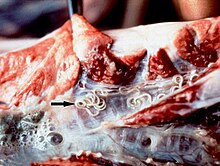Parasitic bronchitis
 From Wikipedia - Reading time: 4 min
From Wikipedia - Reading time: 4 min

Parasitic bronchitis, also known as hoose, husk, or verminous bronchitis,[1] is a disease of sheep, cattle, goats,[2] and swine caused by the presence of various species of parasite, commonly known as lungworms,[3] in the bronchial tubes or in the lungs. It is marked by cough, dyspnea, anorexia and constipation. Lungworms which cause parasitic bronchitis include nematodes of the genera Dictyocaulus, Metastrongylus, and Protostrongylus.[4] Hoose is essentially an infantile disease, almost always afflicting animals under one year of age.[5]
It can be diagnosed through fecal examination[6] or taking a sputum sample[7] and treated by killing the nematode larvae and adults.[8] In severe cases, additional antibiotics may be needed.[7] The most effective prevention is via vaccination, especially important for cattle.[9]
Cause
[edit]The cause for parasitic bronchitis is the nematode called Dictyocaulus viviparus.[8] In the infected animal's fecal matter the larvae later become infective.[8] When animals eat in the infected pasture they ingest the parasite.[10] As the larvae travel towards the respiratory system, they mature, and by the time they reach the lungs, they are full adults.[10] Once they reach the lungs the females lay eggs and once they hatch the new larvae travel up the windpipe to be swallowed and then expelled, repeating the cycle.[8] Some high-risk conditions where D. viviparus is most commonly located are wet pastures with swampy areas,[8] mainly between June and November.[7]
Symptoms
[edit]The main symptoms include breathing difficulties and coughing.[11] The respiratory rate will increase and the animal will cough frequently.[9] There can be audible abnormal breathing sounds.[9] Some animals will show major weight loss.[9] In cattle, there will be reduced milk production.[7] When attempting to cough or expel air, the animal will continually take a position where its head, neck, and tongue are stretched out.[7] They can also show a mild to high fever.[11] In severe cases, it could result in the death of the animal.[8]
Diagnosis
[edit]When diagnosing parasitic bronchitis, it is mainly based on the symptoms and grazing habits.[7] There are multiple methods to diagnosing parasitic bronchitis.[6] One of which is through fecal examination.[6] Usually, either the Baermann technique or flotation is used.[9] This is to detect any larvae that are in the intestines.[6] Another method is by taking a sputum sample.[7] This is a mixture of saliva and mucus coughed up from the lungs.[12] The sample is then examined for traces of eggs or larvae.[7] This method is more sensitive than a fecal sample.[7] Taking blood or milk samples could also prove the presence of the parasite.[9] By using ELISA tests, any antibodies toward the parasite will be detected.[9]
Treatment
[edit]In order to treat the parasite, all forms of anthelmintics are effective in killing both the developing larvae and adult D.viviparus.[8] As soon as an animal is showing symptoms, they should be treated.[7] If they aren't treated before it becomes severe then the animal may not respond to the medicine or if there are very high numbers of parasites then killing them could result in the airways being blocked by the dead larvae.[8] In severe cases, some will require an additional antibiotic.[7]
Prevention
[edit]The most effective method to prevent an outbreak is through vaccination.[9] The vaccination includes a small dose of irradiated infectious larvae.[9] This is given orally in two doses four weeks apart.[9] It is important to treat all animals such as cattle.[9] Despite it being effective, small amounts of lungworm can still appear.[7] Some other methods of prevention are avoiding wet pastures, rotating the use of grazing pastures, having a closed herd policy, and preventing any outside exposure.[8]
References
[edit]- ^ Pease, RW Jr. (1995). "Hoose". Merriam-Webster's medical dictionary. Springfield, Mass.: Merriam-Webster Inc. p. 295. ISBN 9780877799146.
- ^ Boden, E; Andrews, A, eds. (2015). "Parasitic bronchitis". Black's Veterinary Dictionary (22nd ed.). Bloomsbury. p. 639. ISBN 9781408181287.
- ^ Bowsman, DD; Zajac, AM (2014). "Parasitic bronchitis and pneumonia". In Smith, BP (ed.). Large Animal Internal Medicine (5th ed.). Elsevier Health Sciences. pp. 625–628. ISBN 9780323088404.
- ^ Flint, Charles Louis (1859). Milch Cows And Dairy Farming; Comprising The Breeds, Breeding, And Management, In Health And Disease, Of Dairy And Other Stock, The Selection Of Milch Cows, With A Full Explanation Of Guenon's Method; The Culture Of Forage Plants, And The Production Of Milk, Butter and Cheese. Boston, MA: Phillips, Sampson and Company. p. 286. ISBN 1-4086-2818-X.
- ^ Walley, Thomas (1879). The four bovine scourges: pleuro-pneumonia, foot-and-mouth disease, cattle plague, tubercle. Oxford University. p. 23.
- ^ a b c d "Parasitic Infectious/ Parasitic diseases Bronchitis in cattle" (PDF). May 2014.
- ^ a b c d e f g h i j k l "Control of lungworm in cattle" (PDF). Control of Worm Sustainable. August 2014.
- ^ a b c d e f g h i "Lungworm in Cattle". Farm Health Online.
- ^ a b c d e f g h i j k "Lungworm Infection in Animals - Respiratory System". MSD Veterinary Manual. Retrieved 2021-11-30.
- ^ a b McNulty, Samantha N.; Strübe, Christina; Rosa, Bruce A.; Martin, John C.; Tyagi, Rahul; Choi, Young-Jun; Wang, Qi; Hallsworth Pepin, Kymberlie; Zhang, Xu; Ozersky, Philip; Wilson, Richard K. (2016-02-09). "Dictyocaulus viviparus genome, variome and transcriptome elucidate lungworm biology and support future intervention". Scientific Reports. 6 (1): 20316. Bibcode:2016NatSR...620316M. doi:10.1038/srep20316. ISSN 2045-2322. PMC 4746573. PMID 26856411.
- ^ a b "Worm bronchitis, a parasitic and respiratory disease cattle". in.virbac.com. Retrieved 2021-11-30.
- ^ "Sputum: Definition, colors, causes, and when to see a doctor". www.medicalnewstoday.com. 2017-08-13. Retrieved 2021-11-30.
 KSF
KSF